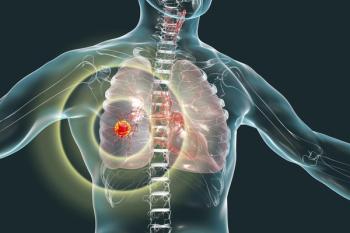
Addition of Best Supportive Care to Pembrolizumab Significantly Improved Survival for Advanced HCC
Patients with advanced hepatocellular carcinoma achieved a statically significant and clinically meaningful survival benefit following treatment with pembrolizumab and best supportive care in the second line.
Adding the use of best supportive care to second-line pembrolizumab (Keytruda) in patients with advanced hepatocellular carcinoma (HCC) from Asia elicited a statistically significant and clinically meaningful survival benefit, according to data presented at the 2022 Gastrointestinal Cancers Symposium.
In the phase 3 KEYNOTE-394 trial (NCT03062358), pembrolizumab achieved a median overall survival (OS) of 14.6 months (95% CI, 12.6-18.0) compared with 13.0 months (95% CI, 10.5-15.1) for those receiving placebo (HR, 0.79; 95% CI, 0.63-0.99). The prespecified P value required for statistical significance was .0193, and this trial showed a P value of .0180 for OS. The 24-month OS rates were 34.3% and 24.9% for pembrolizumab and placebo, respectively.
“The data observed in this study reinforce observation in globally-conducted studies of pembrolizumab in the second-line treatment of advanced HCC and provide support for the generalizability of the data worldwide,” Shukui Qin, MD, PhD, from Jinling Hospital, Nanjing University of Chinese Medicine, Nanjing, China, said in his presentation.
Due to the efficacy and manageable adverse event profile seen with pembrolizumab in the KEYNOTE-224 trial (NCT02702414) and KEYNOTE-240 trial (NCT02702401), investigators looked at pembrolizumab in KEYNOTE-394. This was a randomized, double-blind study looking at pembrolizumab plus BSC versus placebo plus BSC in 453 Asian patients with previously-treated advanced HCC.
Patients had to be previously treated with sorafenib (Nexavar) or oxaliplatin-based chemotherapy to be enrolled. Patients also needed to have Child-Pugh class A, Barcelona Clinic Liver Cancer stage B or C, and an ECOG performance status of 0 or 1.
The primary end point was OS and secondary end points included progression-free survival (PFS), objective response rate (ORR), and duration of response (DOR). Patients were randomized 2:1 to pembrolizumab at 200 mg every 3 weeks (n = 300) versus placebo every 3 weeks (n = 153), both with BSC for up to 35 cycles.
“A total of 50.7% patients in the pembrolizumab group and 66.7% in the placebo group received a systemic anticancer therapy after discontinuation of study treatment,” Qin, the lead study author, said. Post-study anticancer therapy used for patients after they progressed may have attenuated the observed treatment effect, according to the trial investigators.
In patients on the KEYNOTE-394 trial, the PFS rate at 24 months was 11.0% with pembrolizumab and 9% with placebo. Median PFS was 2.6 months (95% CI, 1.5-2.8) with pembrolizumab versus 2.3 months (95% CI, 1.4-2.8) with placebo (HR, 0.74; 95% CI, 0.60-0.92). The P value was .0032, surpassing the prespecified .0134 required for statistical significance.
Patients given pembrolizumab had an ORR of 12.7% (95% CI, 9.1%-17.0%) compared with 1.3% (95% CI, 0.2%-4.6%) for those given placebo. The prespecified P value was .0091 and this demonstrated a P value of less than .0001. Six patients achieved complete response with pembrolizumab versus 1 with placebo, and partial response was seen in 32 of those given pembrolizumab versus 1 given placebo. The median DOR was 23.9 months and 5.6 months with pembrolizumab and placebo, respectively.
Furthermore, a meta-analysis of KEYNOTE-394 and KEYNOTE-240, a phase 3 study of a similar patient population also receiving pembrolizumab plus BSC, was done in the intent-to-treat groups of both studies. Investigators observed a meaningful improvement in the pembrolizumab arm compared with the placebo arm. The median OS in the analysis was 14.2 months (95% CI, 12.8-16.2) for pembrolizumab compared with 12.5 months (95% CI, 10.2-13.6) for placebo (HR, 0.79; 95% CI, 0.67-0.93).
“Pembrolizumab was associated with a manageable adverse event [AE] profile, which was consistent with [the toxicity] profile in previous studies,” Qin said.
Almost 70% of patients receiving pembrolizumab experienced treatment-related AEs (TRAEs) of any grade compared with 49.7% of patients receiving placebo. Grade 3 to 5 TRAEs were observed in 14.4% and 5.9% of patients given pembrolizumab versus placebo, respectively. Four percent of patients receiving pembrolizumab discontinued treatment because of TRAEs compared with 0.7% for placebo. There were 3 patients who had TRAEs leading to death, and none with placebo.
Reference
Qin S, Chen Z, Fang W, et al. Pembrolizumab plus best supportive care versus placebo plus best supportive care as second-line therapy in patients in Asia with advanced hepatocellular carcinoma (HCC): Phase 3 KEYNOTE-394 study. J Clin Oncol. 2022;40(suppl4):383. doi:10.1200/JCO.2022.40.4_suppl.383
Newsletter
Stay up to date on recent advances in the multidisciplinary approach to cancer.


















































































